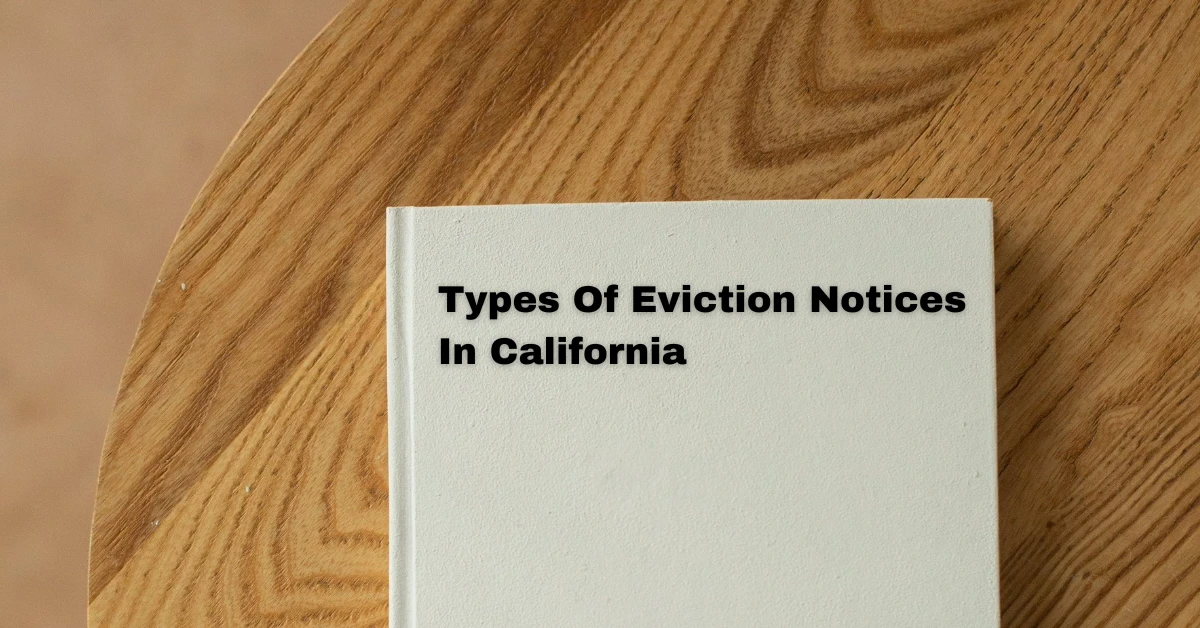
Shunning verbose explanations, we’ll dive straight into the legal nitty-gritty, eliminating any confusion. So, buckle up, and let’s decipher this intriguing query together. Does that sound good?

Eviction is a legal process that landlords in California use to regain possession of their rented property from a tenant who violates their lease agreement.
The first step in the eviction process is serving an eviction notice.
In California, landlords must follow strict laws and regulations when it comes to eviction notices.
Understanding the basics of eviction notices is essential for both landlords and tenants.
An eviction notice is a legal document that notifies a tenant that they must move out of their rental unit by a certain date.
The notice is given without a court order and is the first step in the eviction process.
The different types of eviction notices in California include:

This notice is given to a tenant who fails to pay rent on time. It gives the tenant 3 days to pay the rent or move out of the rental unit.
This notice is given to a tenant who has violated their lease agreement, such as having a pet when pets are not allowed.
Read About: Can a Landlord Refuse Partial Payment: Debunking the MythsIt gives the tenant 3 days to correct the violation or move out of the rental unit.
This notice is given to a tenant who has committed a serious lease violation, such as damaging the rental unit or using it for illegal activities.
It gives the tenant a 3-day notice to move out without the option to fix the violation.
California law requires that eviction notices contain specific information, including the reason for the notice, the date it was served, and the date the tenant must vacate the rental unit.
The notice must also include information on the tenant’s rights and responsibilities.
Failure to comply with these requirements can result in the court dismissing an eviction case.
Understanding the basics of eviction notices is essential for landlords and tenants in California.

Landlords must strictly follow the laws and regulations for eviction notices to avoid legal consequences, while tenants must be aware of their rights and options when served with an eviction notice.
A verbal eviction notice is a type of notice that a landlord gives to the tenant, informing them that they must vacate the rental property within a certain time frame.
Unlike a written eviction notice, it is given verbally, which can often lead to confusion about its legality.
In California, there are specific rules and regulations regarding verbal eviction notices.
Under California law, a verbal eviction notice is not considered to be a legal form of eviction notice.
Read About: Can a Landlord Break a Lease in California: Know Your Rights!The landlord must provide a written notice to the tenant, which must include the reason for the eviction, the date by which the tenant must vacate the property, and the consequences if the tenant does not comply with the notice.
Failure to provide the tenant with a written notice can result in legal action being taken against the landlord.
There are cases when verbal eviction notices are considered to be legal in California.
For instance, if the tenant agrees to vacate the rental property and sign a move-out agreement, a verbal agreement can be made.
However, it is always advisable to have a written agreement to avoid any complications that may arise in the future.
On the other hand, if a landlord uses a verbal eviction notice to force the tenant to leave without following the legal procedures, it is considered illegal and unethical.
It is important for tenants to understand their rights and seek legal advice if they feel that they are being unfairly evicted.
A verbal eviction notice is not legal in California, and landlords must provide written notice to tenants.
It is essential for both landlords and tenants to understand their legal rights to avoid legal disputes.
A verbal eviction notice is when a landlord verbally tells a tenant to leave the rental unit.
No, a verbal eviction notice is not legal in California. A landlord must provide written notice.
Read About: Can Landlord Sue Me for Damages? Rental AwarenessA written eviction notice in California should include the reason for the eviction and a date to vacate.
After receiving an eviction notice, a tenant should carefully read it, seek legal advice, and respond promptly.
Navigating eviction rules can be complex, but know this: a verbal eviction notice isn’t enough in California.
You need an official, written notice for it to be legal. Protect your rights and always demand proper procedures from your landlord.
Why is a verbal eviction illegal while a verbal rental agreement is not?
Al Amin says:Great question! The distinction largely comes down to legal protection and clarity for both parties involved. In California, while a verbal rental agreement might be valid for month-to-month tenancies, it’s not as concrete or clear as a written agreement. On the other hand, eviction has serious consequences for tenants, such as potential homelessness or credit impacts. Therefore, to ensure the tenant’s rights are protected and the reason for eviction is clear and justifiable, a written eviction notice is mandated by law. It creates a paper trail and reduces misunderstandings that can arise from verbal communications.
Stay informed and always consult with a legal expert when in doubt!
Alicia G says:How can I as a master tenant evict a subtenant in California for not paying rent/utilities? They are not on lease but landlord knows.
Al Amin says:In California, the process for evicting a subtenant who is not on the lease but known to the landlord can be somewhat complex. Here are the general steps you can follow:
1. Review Your Lease Agreement: First, review your lease agreement with your landlord to understand the terms regarding subletting. Some leases prohibit subletting without the landlord’s written consent, while others may allow it. Understanding your lease terms is crucial.
2. Communicate with the Subtenant: Start by communicating with your subtenant about the issues, such as unpaid rent/utilities. Try to resolve the matter amicably through negotiations or payment plans if possible.
3. Serve a Written Notice: If the issue remains unresolved, you may need to serve a written notice to the subtenant. In California, this typically involves serving a “3-Day Notice to Pay Rent or Quit” if the issue is non-payment of rent. The notice should specify the amount owed, the due date, and that the subtenant has three days to pay or vacate.
4. Wait for the Response: After serving the notice, you must wait for the three-day period to expire. If the subtenant pays the rent owed within this time frame, the issue is resolved. If not, you can proceed to the next step.
5. File an Unlawful Detainer Lawsuit: If the subtenant does not comply with the notice and does not vacate, you will need to file an unlawful detainer lawsuit in the appropriate California court. This is a legal action to regain possession of the property.
6. Serve Summons and Complaint: After filing the lawsuit, you must serve the subtenant with a summons and complaint, notifying them of the lawsuit and the court date. This step is usually performed by a process server.
7. Attend Court Hearing: Attend the court hearing on the specified date. If the subtenant does not show up or the court rules in your favor, you may obtain a judgment for possession of the property.
8. Obtain a Writ of Possession: If you win the case, you will need to obtain a writ of possession from the court. This writ allows law enforcement to physically remove the subtenant from the property.
9. Enforce the Writ: Once you have the writ, law enforcement will assist you in removing the subtenant from the property.